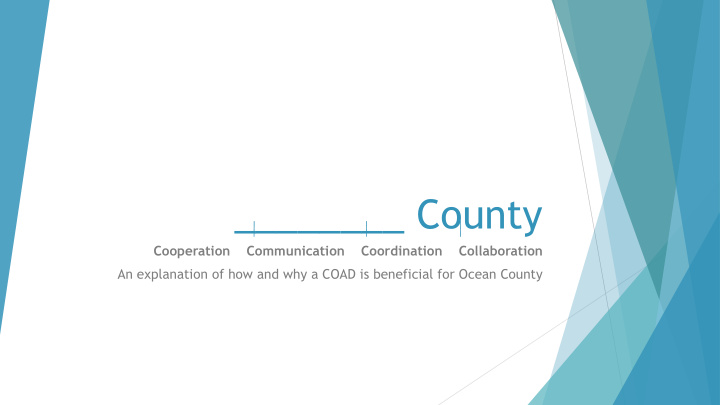



________ County Cooperation Communication Coordination Collaboration An explanation of how and why a COAD is beneficial for Ocean County
What is a COAD? u COAD: Community Organizations Active in Disaster u Forum where organizations share knowledge and resources throughout the disaster cycle— preparation, response and recovery —to help disaster survivors and their communities; u Comprised of membership from various sectors of the community
Building a COAD: Leadership & Membership Examples of Member Organizations Essential Parts Non- Profit Community u u Leadership Local non-profits (Community Action Agencies, Volunteer u Centers, Habitat for Humanity, American Red Cross, u Members etc..) Faith- Based Community u u Relationships Business Community u Government Agencies u County OEM (Office of Emergency Management), Health u Department, Mental Health, etc.. CERT (Community Emergency Response Team) u MRC (Medical Reserve Corp) u Utility Companies u Business Community u Chamber of Commerce, The Home Depot, Banks, etc.. u
COAD Chain of Support u Local COAD (County COAD) State VOAD (NJVOAD) National VOAD (NVOAD) u COAD- Community Organizations Active in Disaster u VOAD- Voluntary Organizations Active in Disaster u Only difference is COAD is open to the whole community, not just the voluntary organizations u New Jersey is represented by NJVOAD which supports county and regional COADs/VOADs, and participates at the national VOAD level, NVOAD
The Four C’s u Cooperation: recognizing that we need each other, acknowledging that each member organization adds value, and understanding that our common goals for the community are best achieved when we work together. u Communication: fostering a climate of openness which promotes sharing of information among members, and actively disseminating information to partners through social media, newsletters, directories, research and demonstration, case studies, and critique. u Coordination: establishing processes to work together in a non-competitive manner to effectively utilize resources among member organizations and state and national partners. u Collaboration: identifying shared goals and developing strategic partnerships to actively work together to accomplish the VOAD mission.
How the COAD Can Benefit Ocean County Community Benefits: u Increased preparedness for whatever disasters lie ahead u Advance planning / convening pre-disaster u Providing disaster response support in coordination with Office of Emergency Management (OEM) u Increased communication, coordination, collaboration and cooperation between all sectors u Organizational Benefits: u Networking and coordination during “blue sky” periods as well as in disaster u Building and strengthening relationships between governmental and non- governmental organizations u Sharing of resources and knowledge to avoid duplication of efforts u Maintaining lines of communication among all members u Coordinating volunteers/ food distribution/ member resources u Personal Benefits: u Increased awareness of community risks and responses to potential disasters u Relationships and partnerships with like-minded professionals u
_____ County Natural Disasters u Waterspout u Thunder Storms u June 24, 2015 u Winter Storms u Gusts up to 72mph u Forest Fires u Hurricanes u September 2015, 1,000 acres burned in the Pinelands u Superstorm Sandy – October 2012 u Earthquakes u Hurricane Irene – August 2011 u December 13, 2014 1.9 magnitude u Flooding earthquake near West Freehold u October 2015; 1 person died
Disaster Damage u Ocean County, according to Time Magazine, is u NOAA estimated Ocean County had $10 billion in Sandy damage the country’s most dangerous county for frequency of natural disasters u According to The Weather Channel analysis Ocean County: u 1996-2013 $11.1 billion in disaster damages u Ranked No. 1 in the Northeast, No. 22 nationally, in terms of damage per capita
How a COAD Works u All organizations involved in disaster preparedness, response and/or recovery are eligible and encouraged to join their local VOAD/COAD u Meetings are, generally, held once a quarter u Committees are formed to work on issues u Trainings, simulations and resources are provided to help the member agencies prepare for disasters
How to Get Started u Become a COAD member u Make sure you are signed up! u Sign-up at the registration table to be on our committees and the email list u Stay Tuned For More Information In Your Email u Nomination Information u Next Meeting Details u Email Next Meeting will be _______
Recommend
More recommend